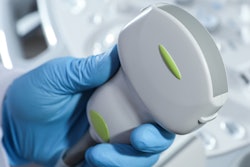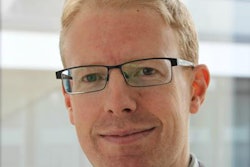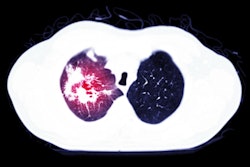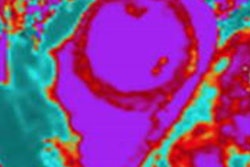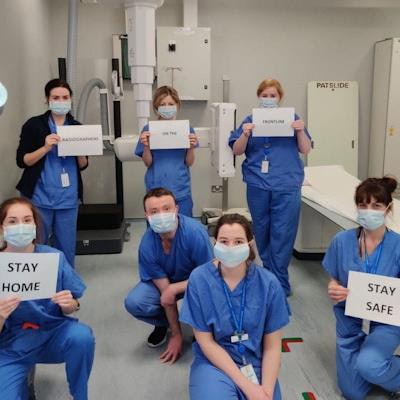
There are some silver linings to the COVID-19 crisis, and one of them is the pandemic's impact on radiography training, Pete Bridge, PhD, senior lecturer in therapeutic radiography at the University of Liverpool, U.K., told attendees at the ECR 2021 professional challenges session on 3 March.
"Are we ready for the next pandemic? There certainly will be another one. Maybe our higher education institutes are a little more robust now and better able to cope," he said.
The crisis has led to rapid uptake of simulation, remote teaching, and online assessment and learning solutions, he said. Online and virtual activities will continue to play an important role, but work is needed to identify an optimal blend. Bridge flagged how the sharing of ideas and resources was originally adopted enthusiastically and the international collaborative approach should hopefully continue through the pandemic and beyond.
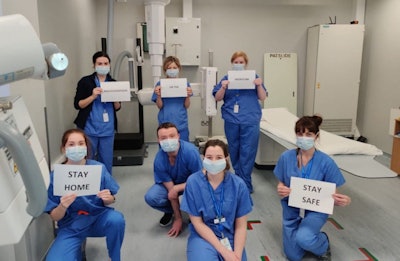 Radiographers have worked on the frontline during the past 12 months. Photo courtesy of Jonathan McNulty, PhD, University College Dublin.
Radiographers have worked on the frontline during the past 12 months. Photo courtesy of Jonathan McNulty, PhD, University College Dublin.Drastic changes to teaching methods specifically resulted from the cessation of clinical placements, lectures, and face-to-face support. This led to development of simulation and remote clinical skills training as well as distance learning when institutes closed. Meanwhile, mentors have had to provide alternative pastoral care for students, Bridge noted in one of a series of radiographers' sessions held at ECR 2021.
Clinical placement stopped in the summer of 2020 as departments reduced footfall and this has only recently resumed with limited capacity, he continued. Second-year students bore the brunt of placement restrictions as they were mid-course and were trying to learn a maximum of skills to prove competency in various techniques. Third-year students experienced an accelerated clinical competency sign-off so that they could graduate.
Innovative tools
Meanwhile, institutes have plowed resources into bridging the face-to-face teaching gap.
The University of Liverpool for its part has focused on simulation resources (including simulated placements) to help address the placement issues. This has been based on remote use of video resources, remote access to virtual reality equipment, and zoom sessions for interpersonal skills simulations whereby students can talk to actors as though they were patients.
"There has been a real enthusiasm for simulation in education, and for collaboration. And I hope this continues," Bridge said.
For academic interaction such as lectures and tutorials, videoconferencing tools like Teams and Zoom have come to the fore. For their part, students have reported that video conferencing is useful -- and economical, as less time and money is spent traveling -- noted Bridge. However, those providing feedback unanimously want onsite learning again, with at least some teaching to resume a face-to-face format, he said.
The issue of online exams has been problematic because they are difficult to invigilate.
Instead, Liverpool University is now delivering open book exams and conducting plagiarism analysis by checking work against a repository for cut and pasted text. Furthermore, using this method, universities can avoid the costs of invigilators.
Student isolation
The closure of campus was an issue that was harder to navigate, and which particularly impacted first-year students.
"Year one is when you're leaving home, and stamping your ID on life, where you meet your friends for life, develop social skills and join crazy societies. All students reported feelings of isolation," he told listeners.
Safeguarding against student isolation has been high on the agenda at Liverpool, particularly for international students. Radiography students can participate in regular online catchups. Bridge pointed to the weekly informal quiz, the sofa quiz -- rather than pub quiz – which helps students to mix and develop common ground.
"It will be challenging to put these solutions away. I think we will continue to use them but not quite as heavily," he said, pointing to the usefulness of the remote exam techniques and teaching and learning assessment strategies. "Students on placements do feel anxiety and depression. Hopefully these remote tools ... will help support students on placements."
New "normal"
Talking about how clinical practices have changed due to COVID-19, Moreno Zanardo, PhD, a researcher at the University of Milan, pointed to the approaches and actions taken to return to usual routine after the challenges of the pandemic, as well as the potential long-term effects of the outbreak on clinical practice.
In the pandemic's second phase, clinical activity restarted and so did screening programs. This led to organizational issues, he noted.
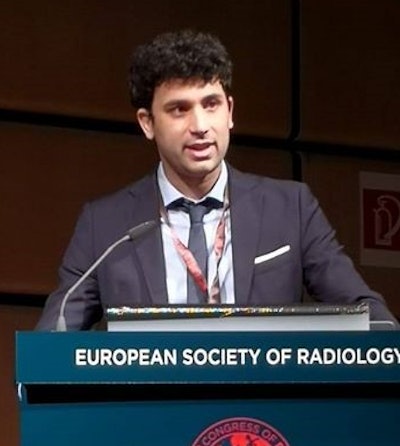 Moreno Zanardo, PhD.
Moreno Zanardo, PhD."During the first lockdown in Italy 1.2 million mammograms were missed due to the suspension of breast cancer screening, and these have to be rescheduled," said Zanardo, who is also a radiographer at the San Donato clinic.
Radiographers also have to engage in new ways of communicating, to help patients get used to considering the hospital a safe place to be again and participating in screening programs. He also highlighted how mobile radiography has become a new weapon against the pandemic, with proposals for implementation of home visits by radiographer and nurse teams to carry out chest x-ray, nasopharyngeal swabs, and home isolation support when emergency measures cease.
"In terms of the potential long-term effects -- many aspects of our lives will never be the same. Some aspects hopefully won't return to the 'old' normal, but reach a new normal," he said.
Stress busting
Speaking about well-being in an era of COVID fatigue, Paul Bezzina, PhD, head of radiography at the University of Malta, described how colleagues were afraid of face-to-face lectures with students and encounters with patients. There need to be short and long-term plans to promote mental health during and after the pandemic, he noted, with institutional structures providing support to staff.
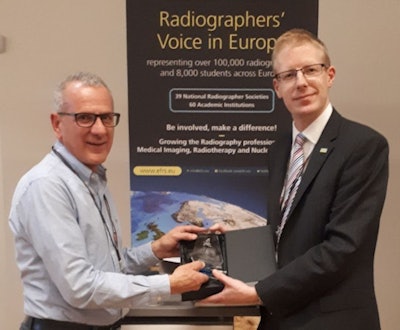 Paul Bezzina, PhD, (left) receives an award at a previous ECR from Jonathan McNulty, PhD, immediate past president of the European Federation of Radiographer Societies.
Paul Bezzina, PhD, (left) receives an award at a previous ECR from Jonathan McNulty, PhD, immediate past president of the European Federation of Radiographer Societies.Importantly, professionals need to recognize the symptoms of stress, including anger, depression, irritation, feelings of powerlessness, denial, sleeplessness, and fatigue. Strategies such as education and training, and regular stress evaluation sessions among radiography staff can help, he said, as will communication among coworkers.
"Recognize you are playing a crucial role and are doing your best," he said.
Other tips included keeping daily routines as similar as possible to prepandemic ones, engaging in physical activity, and taking regular breaks from social media. He urged radiographers to seek help immediately for any alcohol and substance abuse, as well as to engage in mindfulness techniques such as meditation.




